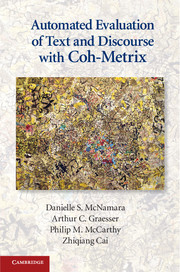Book contents
- Frontmatter
- Dedication
- Contents
- List of Figures
- List of Tables
- Acknowledgments
- Introduction
- Part I Coh-Metrix
- 1 What Is Text and Why Analyze It?
- 2 The Importance of Text Cohesion
- 3 The Science and Technology That Led to Coh-Metrix
- 4 Coh-Metrix Measures
- 5 Coh-Metrix Measures of Text Readability and Easability
- 6 Using Coh-Metrix Measures
- Part II A Beginner’s Guide to Writing Coh-Metrix Research
- Concluding Remarks
- References
- Appendix A Coh-Metrix 3.0 Indices
- Appendix B Coh-Metrix Indices Norms
- Index
3 - The Science and Technology That Led to Coh-Metrix
Published online by Cambridge University Press: 05 June 2014
- Frontmatter
- Dedication
- Contents
- List of Figures
- List of Tables
- Acknowledgments
- Introduction
- Part I Coh-Metrix
- 1 What Is Text and Why Analyze It?
- 2 The Importance of Text Cohesion
- 3 The Science and Technology That Led to Coh-Metrix
- 4 Coh-Metrix Measures
- 5 Coh-Metrix Measures of Text Readability and Easability
- 6 Using Coh-Metrix Measures
- Part II A Beginner’s Guide to Writing Coh-Metrix Research
- Concluding Remarks
- References
- Appendix A Coh-Metrix 3.0 Indices
- Appendix B Coh-Metrix Indices Norms
- Index
Summary
This chapter describes the scientific and technological advances that were the precursors to the development of Coh-Metrix. The Coh-Metrix team has developed numerous computational algorithms and procedures for measuring ease (versus difficulty) at the various levels of language and discourse. We are satisfied with our progress and achievements, but we cannot emphasize too much that Coh-Metrix was hardly built in a vacuum. Coh-Metrix can be viewed as a sandbox of automated language and discourse facilities that were developed not only by our research team but also by others in computational linguistics, corpus linguistics, discourse processes, cognitive science, psychology, and other affiliated fields. We were able to build Coh-Metrix because we had the advantage of standing on the shoulders of giants.
The contributions of our predecessors come in many varieties. Some noteworthy examples of these contributions are highlighted below.
One type of contribution is lexicons or dictionaries of words that list qualitative features or quantitative values for each word. For example, WordNet (Fellbaum, 1998; Miller, Beckwith, Fellbaum, Gross, & Miller, 1990) stores semantic and syntactic features of nouns, verbs, adjectives, and other content words in the English language. The MRC Psycholinguistic Database (Coltheart, 1981) has human ratings of thousands of words on familiarity, imagery, concreteness, and meaningfulness. The CELEX Lexical Database (Baayen, Piepenbrock, & Gulikers, 1995) has estimates of how frequently English words are used in a very large corpus of documents.
A second type of contribution is from applications. An application is a fully functioning program that takes text as input and computes some language or discourse code as output. We use the output when we create a Coh-Metrix measure. A good example of this is when we used a syntactic parser (the one Coh-Metrix uses was based on Charniak, 2000). The parser takes each sentence as input and computes a syntactic tree structure. These tree structures are used when we scale texts on syntactic ease or difficulty.
…
Information
- Type
- Chapter
- Information
- Publisher: Cambridge University PressPrint publication year: 2014
